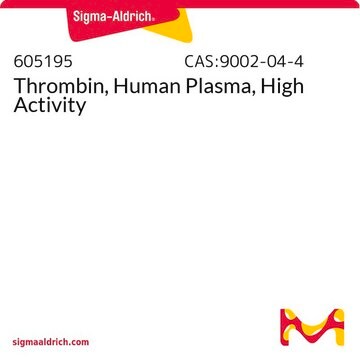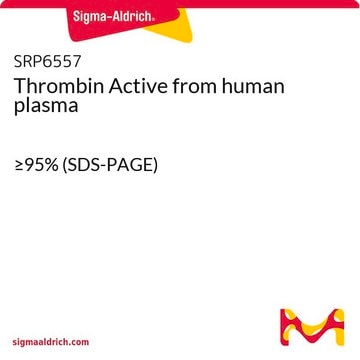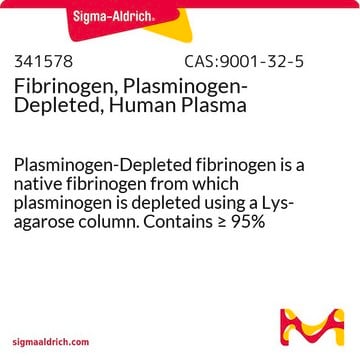605190-M
Thrombin, Human Plasma
Synonym(s):
Thrombin, Human Plasma
Sign Into View Organizational & Contract Pricing
All Photos(1)
About This Item
Recommended Products
biological source
human plasma
Quality Level
form
lyophilized
specific activity
≥1000 NIH units/mg protein
manufacturer/tradename
Calbiochem®
storage condition
OK to freeze
solubility
water: 1 mg/mL
aqueous buffer: soluble
storage temp.
−20°C
General description
Thrombin, a sodium-activated type II enzyme, comprises two anion binding exosites, ABE-I and ABE-II. This serine protease enzyme is synthesized from zymogen prothrombin (factor II) in the liver.
Application
Thrombin, Human Plasma has been used:
- as a component of endothelial growth medium (EGM) media for the transplantation and reisolation of Kaposi′s sarcoma-associated herpesvirus-human endothelial cell line (KSHV-HuARLT) cells from mice
- for the fabrication of fibrin gels
- as a component of EGM media for viral copy number analysis of KSHV-HuARLT cells and matrigel implant
Biochem/physiol Actions
Thrombin cleaves and converts fibrinogen into fibrin. It then activates factors V, VIII, XI, and XIII. Thrombin stimulates platelet activation and stabilizes the fibrin polymers. It elicits a vital role in the last stages of the blood coagulation cascade.
Warning
Toxicity: Harmful (C)
Unit Definition
One unit is determined by comparison with a standard curve prepared using the Bureau of Biologics standard thrombin.
Physical form
Lyophilized from 200 mM NaCl, 50 mM citrate buffer, 0.1% PEG-8000, pH 6.5. Contains BSA as a stabilizer.
Preparation Note
Prepared from plasma that has been shown by certified tests to be negative for HBsAg and for antibodies to HIV and HCV.
Reconstitution
Following reconstitution, aliquot and freeze (-70°C). Stock solutions are stable for up to 2 months at -70°C.
Analysis Note
Complete activation from homogeneous prothrombin by SDS-PAGE
Legal Information
CALBIOCHEM is a registered trademark of Merck KGaA, Darmstadt, Germany
Disclaimer
RESEARCH USE ONLY. This product is regulated in France when intended to be used for scientific purposes, including for import and export activities (Article L 1211-1 paragraph 2 of the Public Health Code). The purchaser (i.e. enduser) is required to obtain an import authorization from the France Ministry of Research referred in the Article L1245-5-1 II. of Public Health Code. By ordering this product, you are confirming that you have obtained the proper import authorization.
Signal Word
Danger
Hazard Statements
Precautionary Statements
Hazard Classifications
Eye Irrit. 2 - Resp. Sens. 1 - Skin Irrit. 2 - STOT SE 3
Target Organs
Respiratory system
Storage Class Code
11 - Combustible Solids
WGK
WGK 1
Flash Point(F)
Not applicable
Flash Point(C)
Not applicable
Certificates of Analysis (COA)
Search for Certificates of Analysis (COA) by entering the products Lot/Batch Number. Lot and Batch Numbers can be found on a product’s label following the words ‘Lot’ or ‘Batch’.
Already Own This Product?
Find documentation for the products that you have recently purchased in the Document Library.
Customers Also Viewed
Segall JA and Liem TK
Congenital and Acquired Hypercoagulable Syndromes, 339-346 (2007)
Kitchens CS, et al
Consultative Hemostasis and Thrombosis (2013)
Isis S R Carter et al.
Thrombosis, 2010, 416167-416167 (2010-01-01)
Although prothrombin is one of the most widely studied enzymes in biology, the role of the thrombin A-chain has been neglected in comparison to the other domains. This paper summarizes the current data on the prothrombin catalytic domain A-chain region
Diana L Diesen et al.
Vascular, 16 Suppl 1, S29-S36 (2008-03-01)
Thrombin is a common hemostatic drug used in surgical practice for over 100 years because of its simplicity and efficacy. Thrombin converts fibrinogen to fibrin, activates platelets, and induces vascular contraction. It is available in multiple forms, including human thrombin
Madhavi A Jadhav et al.
Biochemistry, 49(13), 2918-2924 (2010-03-12)
The formation of a blood clot involves the interplay of thrombin, fibrinogen, and Factor XIII. Thrombin cleaves fibrinopeptides A and B from the N-termini of the fibrinogen Aalpha and Bbeta chains. Fibrin monomers are generated that then polymerize into a
Our team of scientists has experience in all areas of research including Life Science, Material Science, Chemical Synthesis, Chromatography, Analytical and many others.
Contact Technical Service










